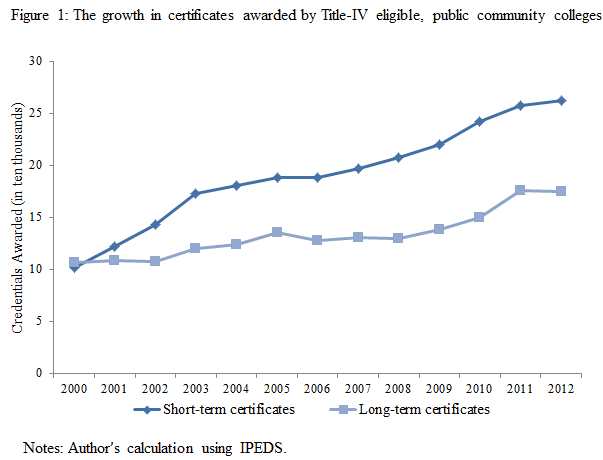Over the past decade there has been tremendous growth in the number of short credentials awarded by public community colleges. These programs of study are explicitly vocational and require fewer credits for completion than an associate’s degree. However, it is not clear whether students benefit from obtaining these certificates. On the one hand, these credentials could be tightly coupled with local labor market needs and provide students with tangible skills that could help them get jobs. On the other hand, these short programs of study could leave students with a credential that means little to employers and offers them no clear avenue to additional schooling.
These credentials are divided into two categories by the Integrated Postsecondary Education Data System (IPEDS). They may be long-term certificates, which require at least one year of full-time study, but less than two years, or short-term certificates, which require less than one year of full-time study. Figure 1 shows the growth in the number of both long- and short-term credentials awarded by Title-IV eligible, public community colleges between 2000 and 2012. During this period, the number of long-term certificates awarded grew by 63 percent while the number of short-term certificates grew by 157 percent. Compare this to the number of associate’s degrees awarded, which grew by only 47 percent over this period (not shown).

These certificates are offered in many different fields including nursing, commercial vehicle operations, law enforcement and business. In 2012, the five most common fields in which short-term certificates were awarded were emergency medical technician, automotive mechanic, welding technologist, commercial vehicle operations, and law enforcement.
If these certificates help students to improve their job prospects, we would expect students’ wages to increase after completing these credentials. However, despite the large growth in the number of students completing these programs, only a limited number of studies to date have examined the financial returns to community college credentials other than associate’s degrees. Jepsen, Troske and Coomes (2014) make use of an administrative dataset from Kentucky, and find returns to both short- and long-term certificates, though the authors find that the returns to short certificates are minimal—approximately $300, per quarter, on average. Dadger and Trimble (2015) estimate the returns to these short credentials for students in Washington State and find large returns, on average, for women earning long-term certificates, but no significant return to short-term certificates for either women or men. These authors also find that, while there are financial returns to associate’s degrees across subjects, the returns to long-term certificates for women are largely driven by program completions in allied health. More research is needed, but these studies suggest that while there are returns to long-term certificates, these returns may be driven by particular fields; in addition, there is less evidence for returns to short-term certificates.
One potential explanation for the minimal financial benefit to students of obtaining short-term certificates, as well as differences in the returns to long-term certificates across fields, may be that not all of these credentials are well recognized by employers. Students who complete a certificate program in a health care-related field may have to take a licensing exam before they are eligible to apply for many of the available jobs. This makes the question of whether employers recognize these short credentials less important in health care-related fields, because the labor market recognizes the national licensing exam. The exam also ensures that students have the knowledge and skills required by the industry. Though there are also licensing exams in fields such as welding, these may not be as widely utilized as the exams for nurse’s assistants and emergency medical technicians.
One way to increase the likelihood that employers will recognize these credentials is to create relationships between community colleges and nearby industries. A paper released in February by the Aspen Institute describes a potential model for building these relationships. The National Coalition of Certification Centers (NC3) is a nonprofit organization that creates networks between community colleges and local industries in order to develop and implement technical certifications that are portable, stackable, and recognized by industry.
There are two particularly compelling features of the NC3 model. First, they develop credentials at the national level before designing and implementing the training programs at local colleges. Though community colleges are often tasked with developing programs that fill local labor force needs, the community college educated workforce may be mobile and so, ideally, credentials students earn would be recognized outside of local labor markets. Second, these credentials are designed to be stackable. A potential downside of certificate programs, which are highly focused on a particular skill set, is that students who earn them may have to retrain every time the local economy changes or they want to advance in their job. If credentials are designed to be stackable then one certificate program builds on another and, ideally, a series of these credentials will add up to an associate’s degree.
The rapid growth in short- and long-term certificates awarded by public community colleges may be a positive development if these programs are providing access to higher education for students who wouldn’t otherwise attend. However, these credentials must be thoughtfully designed if they are to have any hope of improving students’ labor market outcomes or their access to further education.



Commentary
Do students benefit from obtaining vocational certificates from community colleges?
March 28, 2016